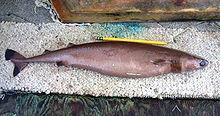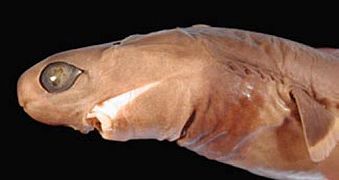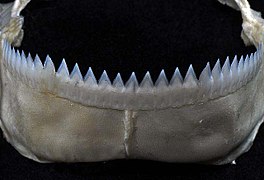Cigar shark
| Cigar shark | ||||||||||||
|---|---|---|---|---|---|---|---|---|---|---|---|---|

Cigar shark ( Isistius brasiliensis ) |
||||||||||||
| Systematics | ||||||||||||
|
||||||||||||
| Scientific name | ||||||||||||
| Isistius brasiliensis | ||||||||||||
| ( Quoy & Gaimard , 1824) |
The cigar shark ( Isistius brasiliensis ) is a small representative of the sharks that belongs to the genus of cigar sharks ( Isistius ) from the family of dogfish (Squalidae).
anatomy
The cigar shark is a maximum of 50 centimeters long and has an evenly brownish color. Near the gills , the animals have a black band that goes around the body. The cigar shark has a short, rounded snout with large eyes set far forward. Its name comes from its body shape. Like its closest relative, the large-tooth cigar shark ( Isistius plutodus ), the cigar shark also has a noticeably “asymmetrical” set of teeth: the teeth of the upper jaw are small and needle-like, while the teeth in the lower jaw have grown together to form a row of teeth. The two dorsal fins ( fins ), of which the first is smaller than the second, start very far back on the back, there are no anal fins and the caudal fin is "asymmetrical" shaped in the side aspect. The fin ends are almost transparent. Although both species are counted among the dogfish, they have no thorns in front of their dorsal fins. They have luminous organs on the underside of the abdomen ; In the case of the cigar shark, only the dark collar area is excluded.
distribution
Since the cigar shark lives in the deeper regions of the oceans from 80 to around 3500 meters depth, it can only be based on selective observations off the Bahamas , off the south coast of Brazil to the Cape Verde Islands , off the south coast of Africa ( Angola to South Africa ), and from Mauritius to New Guinea , off the west coast of Australia , from Japan to Hawaii and the Galápagos Islands can be concluded on a worldwide distribution in the tropical seas. The liver, which is rich in oil, helps the animals move vertically in the water column.
Reproduction
Investigations on a captive, pregnant female show that a number of embryos equipped with a yolk sac grow in the womb and are presumably born after this food supply has been used up (one speaks of ovoviviparia or "aplacental viviparia "). At birth, the animals are believed to be fourteen to fifteen centimeters long. Unborn cigar sharks do not yet have the characteristic set of teeth, nor is their collar colored.
Diet
The cigar shark feeds on invertebrates and on the meat that it bites out of large fish and marine mammals with the help of its teeth. The characteristic cone-shaped scars were found on marine life such as tuna , other sharks , rays , elephant seals and whales . This form of nutrition justifies the English name: Cookiecutter shark , which means something like cookie cutter shark . The German name is also derived from this, since the diet is reminiscent of a notch cutter, with which one end of a cigar is cut.
A bream mackerel ...
... and a female elephant seal with the characteristic bites of a cigar shark
The bioluminescence probably helps the cigar sharks with this type of food intake. Seen from the depths, the glow on the belly side can almost compensate for the brightness of the water surface. The dark spot in the collar region can also simulate the silhouette of a smaller fish. In this way, cigar sharks can attract larger animals, which in turn become prey.
Cigar shark and humans
Due to the small size of the cigar shark, it does not pose a serious threat to humans. However, there have been isolated attacks against humans, for example against scuba divers or castaways who were bite wounds up to 2.5 cm in size during nighttime attacks.
Web links
- Cigar Shark on Fishbase.org (English)
- About cigar sharks at www.hai.ch
- Isistius brasiliensis in the endangered Red List species the IUCN 2006. Posted by: Stevens, 2003. Retrieved on 12 May, 2006.
Individual evidence
- ↑ Heike Zidowitz: On the biology of the genus of the cigar shark Isistius spp. In: Deutsche Elasmobranchier Gesellschaft: Elasmoskop , 2003 ( Memento from September 28, 2007 in the Internet Archive )
- ^ A b Biology of Sharks and Rays: Deep Sea: the Twilight Zone and Beyond: Cookiecutter Shark. Retrieved May 5, 2014 .








